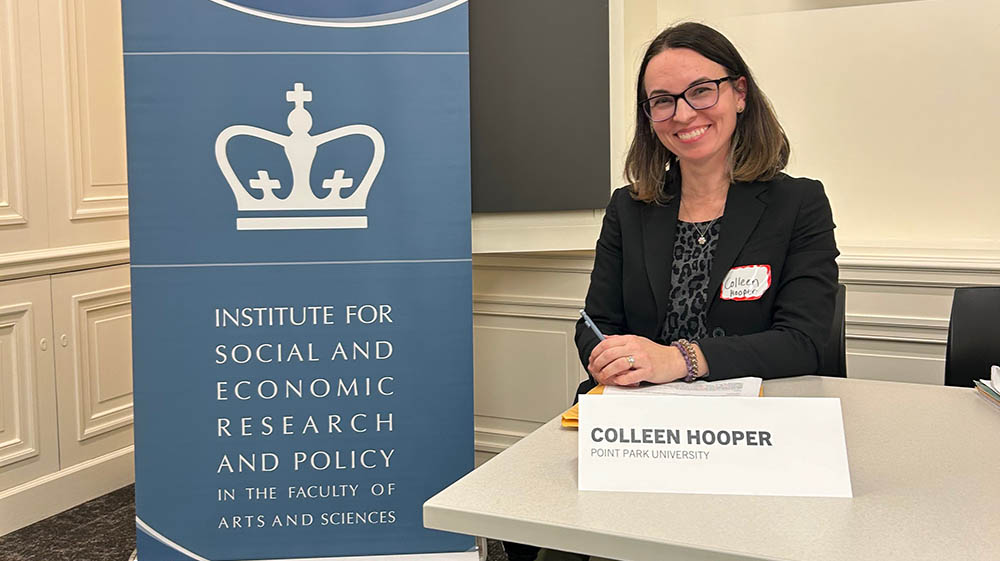Professor Colleen Hooper Authors Book About the History of Dance Labor, Presents at Dance History Conference Friday, January 5, 2024

Colleen Hooper, Ph.D., associate professor of dance, presented at Accumulation: A Conference on Dance History at Columbia University.
"The conference was invigorating. Highlights included learning innovative approaches to research and discussing new methods for bringing media and movement into the dance history classroom."
At Point Park University, our faculty bring their real-life professional experience into the classes they teach, and Associate Professor of Dance Colleen Hooper, Ph.D., is doing just that.
During a recent sabbatical, Hooper wrote new chapters of her book about the history of dance labor. Additionally, she presented at a conference on dance history at Columbia University in New York City.
In the Q&A below, Hooper shares how she connects her research and professional experiences into her classes at Point Park.
Tell us about your participation in the Accumulation Conference at Columbia University.
The Accumulation Conference was invigorating. Highlights included learning innovative approaches to research and discussing new methods for bringing media and movement into the dance history classroom.
The conference was billed as “A Conference on Dance History and the Social Sciences,” and it was sponsored by Columbia University’s Institute for Social and Economic Research and Policy. Fifteen speakers presented on topics that included “Dance Beyond the Concert Stage,” “Doing Dance History” and “Teaching Dance History.” I presented on the panel “Political Economies of Dance,” and my panelists and I each discussed how government policies and economic systems have impacted the dance field.
It was wonderful to hear unpublished research from several scholars, and presenters also shared about their forthcoming books and future projects. Lynn Garafola, dance historian, delivered a memorable opening address that contextualized the dance history field, and Julia Foulkes, a history professor at The New School, presented a closing keynote that urged audience members to consider how dance history research relates to broader issues in our cultural history.
What inspired you to write your new book Dance from Labor to Service in the 20th Century?
When I choreographed and performed in New York City earlier in my career, I considered the question of dance labor and working conditions on a daily basis. As I shifted my focus towards dance history research, I became curious about the history of dance labor.
My book, Dance from Labor to Service in the 20th Century, addresses how federally funded dance employment redefined what dance meant as a job during times of economic hardship. I compare the 1930s Works Progress Administration (WPA) and the 1970s Comprehensive Employment Training Act (CETA) arts programs to reveal how they reflected the economy and creativity of their respective time periods.
Each chapter in my book explores a different version of federally funded dance employment. Four administrative units are presented chronologically to reveal how dance jobs changed over time in relationship to recognizable historical moments. The administrative units are in New York City, Detroit and Philadelphia, and the dancers include Helen Tamiris, Edith Segal, Madeline Cantor, Terry Fox, Merían Soto, Jane Goldberg, Charles "Cookie" Cook and Kenneth King. I am currently in conversations with publishers and awaiting a projected publication date.
Tell us about student Gigi Robinson’s involvement with your research and this book?
Dance major Gigi Robinson has done a wonderful job as my research assistant. She assisted with source citation, summarized articles and provided feedback on some of my writing. It has been valuable to have her involved in multiple aspects of my book project, and I have appreciated her feedback as part of my writing process. She asks great questions, and she has helped me understand parts of my writing that could be clarified and expanded upon.
How do you connect your research on this topic into the courses you teach at Point Park?
In my Dance History courses, we discuss how dancers and choreographers developed their careers and their artistry. This includes researching how dancers are credited for their work and learning about how working conditions in dance companies have changed over time. By understanding the history of dance and labor, my students are better prepared to engage with the dance profession as performers, administrators and audience members.
More About: conference, modern, ballet, faculty, jazz, Conservatory of Performing Arts, dance

